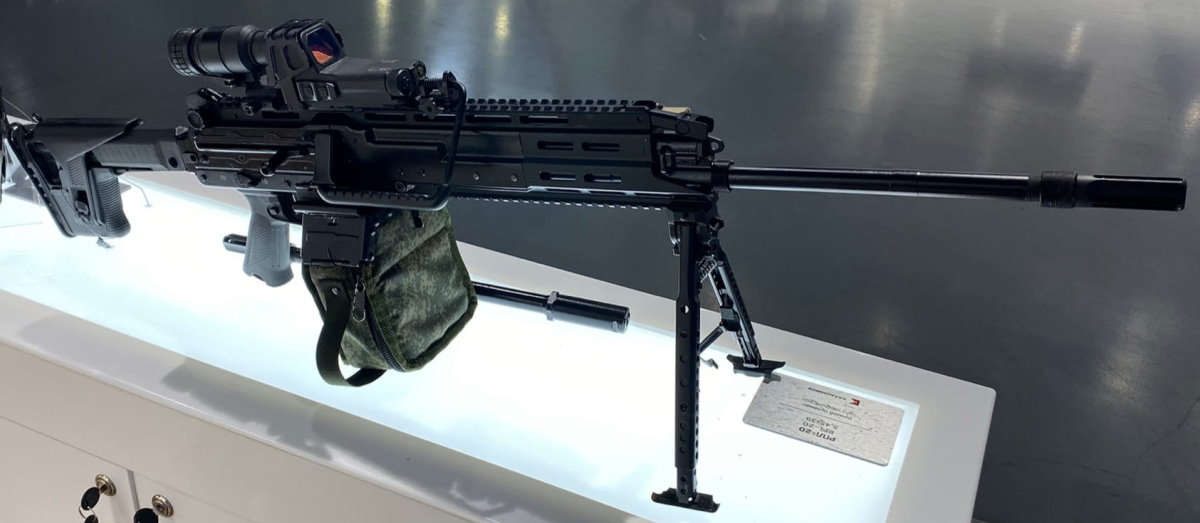The RPL-20: Kalashnikov's Bold Leap into the Future of Infantry Warfare

In the heart of the ever-evolving conflict zone in Ukraine, Russia has quietly unleashed a new weapon designed to redefine the battlefield: the RPL-20. A lightweight, belt-fed machine gun chambered in the ubiquitous 5.45x39mm cartridge, it marks a significant leap forward in Russia's infantry capabilities. While its arrival has been under the radar, it’s clear that the RPL-20 is much more than a mere addition to the arsenal—it’s a calculated evolution in military technology.
Announced by Sergey Urzhumtsev, the chief designer at Kalashnikov Concern, Russia’s iconic firearms manufacturer, the RPL-20's active deployment in Ukraine has sparked interest not just among soldiers, but also among arms dealers, military analysts, and strategists alike. Urzhumtsev’s nonchalant confirmation through state-owned news agency TASS—"I can say that there are machine guns in the area where the special military operation is being conducted"—hints at the weapon’s understated yet potent arrival.
What stands out about the RPL-20 isn’t just its technical specifications but how rapidly it has gone from prototype to deployment. Developed in late 2024, it was officially revealed to the world at ADEX 2024, just a few weeks later. This lightning-fast turnaround speaks volumes about Russia’s evolving military-industrial complex, one that has adapted to survive amid the challenging realities of modern warfare.
The RPL-20 is designed to fill a critical gap in Russia’s infantry lineup. Weighing in at just 5.2 to 5.5 kilograms, it’s light enough to keep troops mobile while maintaining the firepower necessary for sustained engagements. Unlike older magazine-fed light machine guns like the RPK-74, the RPL-20 uses a belt-fed system that ensures longer bursts of fire, crucial for suppressing enemy positions or light vehicles.
Its 5.45x39mm cartridge, shared with Russia’s AK-12 assault rifle, ensures logistical compatibility, making it an easily integrated piece of equipment for Russian forces. Whether in trench warfare or urban skirmishes—hallmarks of the current conflict in Ukraine—the RPL-20’s belt-fed design boosts its capacity for fire support without compromising on mobility.
The versatility of the RPL-20 is underscored by its two available configurations: one with a 590mm barrel for long-range engagements up to a kilometer, and a more compact 415mm barrel designed for close-quarters action. This adaptability makes the RPL-20 a powerful asset in a variety of combat scenarios, from tight urban combat to open-field engagements. Both configurations share the same gas-operated, long-stroke piston mechanism—a signature of Kalashnikov's engineering expertise.
What sets the RPL-20 apart from its predecessors is its thoughtful design, balancing form and function for the modern soldier. The folding telescopic stock, complete with an adjustable cheek rest and shoulder support, ensures a high degree of comfort and precision across different combat stances. Its Picatinny rails, both top and bottom, allow for extensive customization with optical sights, night vision, laser designators, and accessories like bipods or foregrips.
Furthermore, the RPL-20’s specially designed suppressor adds another layer of sophistication. Unlike many traditional suppressors that degrade after extended use, this one is built to withstand heavy firing without compromising performance, capable of enduring 20,000 rounds before showing any signs of wear. This durability is a critical feature for a weapon meant to endure the punishing demands of modern warfare.
The RPL-20 represents a strategic bridge in Russia’s arsenal. It occupies the space between lighter, more portable weapons like the RPK-74 and heavier, general-purpose machine guns like the PKM. While the RPK-74 has been a reliable workhorse since its introduction in the 1970s, it’s limited by its magazine-fed system and relatively short burst capacity. On the other hand, the PKM, with its 7.62mm ammunition, is a formidable suppressive weapon but comes with the drawbacks of weight and limited mobility.
In this regard, the RPL-20’s design—light yet powerful—represents a middle ground that combines the best elements of its predecessors. It ensures greater sustained fire with its belt-fed system while retaining the portability needed for fast-moving infantry squads.
Kalashnikov's rapid development and deployment of the RPL-20 come at a time when Russia’s arms industry has faced immense pressure. Western sanctions, which have targeted Russia’s defense sector since the annexation of Crimea in 2014, were intensified following the 2022 invasion of Ukraine. These sanctions aimed to cripple Russia’s military-industrial complex by cutting off access to critical foreign technology, capital, and markets. Yet, Kalashnikov has managed to adapt and innovate under these harsh conditions.
With a heavy reliance on domestic resources, Kalashnikov bypassed the need for foreign components by ramping up in-house research and development. The result is the RPL-20, a weapon conceived not through direct military funding, but driven by Kalashnikov’s own initiative. This resilience has ensured that, despite the external pressure, Russia’s arms industry has continued to evolve at an impressive pace, with the RPL-20 and other advanced weaponry rolling off the production lines to meet the demands of the battlefield.
Kalashnikov’s ambitions are not limited to the Russian military. At ADEX 2024, the company not only showcased the RPL-20 but also announced plans to produce variants in 7.62x39mm and 5.56x45mm calibers, signaling its intent to tap into international markets. With Russia’s pivot to allies such as China, India, and Iran, Kalashnikov has found new avenues to secure the components and trade opportunities needed to thrive despite Western restrictions.
The RPL-20’s potential appeal extends beyond Russia’s borders, offering a versatile, rugged, and highly adaptable solution for modern militaries facing complex, dynamic combat scenarios.
In a conflict where every advantage counts, the RPL-20 is more than just another weapon—it’s a statement of Kalashnikov's innovation and resilience. As it joins Russia's growing arsenal, it reflects the country’s ongoing commitment to adapting, overcoming adversity, and pushing the boundaries of modern warfare. Whether it becomes a mainstay on the front lines of Ukraine or takes on a larger role in Russia’s international arms trade, the RPL-20 is poised to become a key player in the evolution of infantry warfare.
 Latest news
Latest newsGeorgia and the European Union: Transformation of Foreign Policy in the Context of European Integration
11.Dec.2025
Half of Azerbaijanis’ Income Goes to Food: Hidden Causes and Possible Consequences for the Economy
11.Dec.2025
Ukraine on the Threshold of a Political Shift: Updated Peace Plan and Zelensky’s Statement on Readiness for Elections
10.Dec.2025
Russia Proposes New Medal for Evacuating Bodies from Combat Zones
09.Dec.2025
The Shadow of Kadyrov in Yerevan: How a Woman Who Fled Violence Was Killed?
09.Dec.2025
Ukraine is Strengthening its Army amid a Growing Threat
08.Dec.2025
Ukraine Strengthens Its Army Amid Growing Threats
08.Dec.2025
Moscow and Beijing Conduct New Air-Defense Drills: What Lies Behind the Strengthening of Their Joint Shield?
07.Dec.2025
Russia–India: A New Architecture of Partnership. What Stands Behind Putin’s Visit to New Delhi?
06.Dec.2025
The National Security Strategy of Armenia: Analysis of Current Threats and Strategic Approaches
05.Dec.2025

 15 Dec 2025
15 Dec 2025








